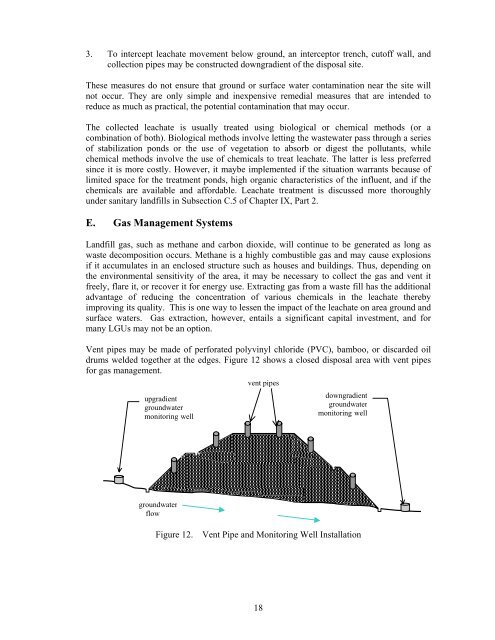Closing an Open Dumpsite and Shifting - International ...
Closing an Open Dumpsite and Shifting - International ...
Closing an Open Dumpsite and Shifting - International ...
Create successful ePaper yourself
Turn your PDF publications into a flip-book with our unique Google optimized e-Paper software.
3. To intercept leachate movement below ground, <strong>an</strong> interceptor trench, cutoff wall, <strong>an</strong>d<br />
collection pipes may be constructed downgradient of the disposal site.<br />
These measures do not ensure that ground or surface water contamination near the site will<br />
not occur. They are only simple <strong>an</strong>d inexpensive remedial measures that are intended to<br />
reduce as much as practical, the potential contamination that may occur.<br />
The collected leachate is usually treated using biological or chemical methods (or a<br />
combination of both). Biological methods involve letting the wastewater pass through a series<br />
of stabilization ponds or the use of vegetation to absorb or digest the pollut<strong>an</strong>ts, while<br />
chemical methods involve the use of chemicals to treat leachate. The latter is less preferred<br />
since it is more costly. However, it maybe implemented if the situation warr<strong>an</strong>ts because of<br />
limited space for the treatment ponds, high org<strong>an</strong>ic characteristics of the influent, <strong>an</strong>d if the<br />
chemicals are available <strong>an</strong>d affordable. Leachate treatment is discussed more thoroughly<br />
under s<strong>an</strong>itary l<strong>an</strong>dfills in Subsection C.5 of Chapter IX, Part 2.<br />
E. Gas M<strong>an</strong>agement Systems<br />
L<strong>an</strong>dfill gas, such as meth<strong>an</strong>e <strong>an</strong>d carbon dioxide, will continue to be generated as long as<br />
waste decomposition occurs. Meth<strong>an</strong>e is a highly combustible gas <strong>an</strong>d may cause explosions<br />
if it accumulates in <strong>an</strong> enclosed structure such as houses <strong>an</strong>d buildings. Thus, depending on<br />
the environmental sensitivity of the area, it may be necessary to collect the gas <strong>an</strong>d vent it<br />
freely, flare it, or recover it for energy use. Extracting gas from a waste fill has the additional<br />
adv<strong>an</strong>tage of reducing the concentration of various chemicals in the leachate thereby<br />
improving its quality. This is one way to lessen the impact of the leachate on area ground <strong>an</strong>d<br />
surface waters. Gas extraction, however, entails a signific<strong>an</strong>t capital investment, <strong>an</strong>d for<br />
m<strong>an</strong>y LGUs may not be <strong>an</strong> option.<br />
Vent pipes may be made of perforated polyvinyl chloride (PVC), bamboo, or discarded oil<br />
drums welded together at the edges. Figure 12 shows a closed disposal area with vent pipes<br />
for gas m<strong>an</strong>agement.<br />
vent pipes<br />
upgradient<br />
groundwater<br />
monitoring well<br />
groundwater<br />
flow<br />
Figure 12. Vent Pipe <strong>an</strong>d Monitoring Well Installation<br />
18<br />
downgradient<br />
groundwater<br />
monitoring well

















